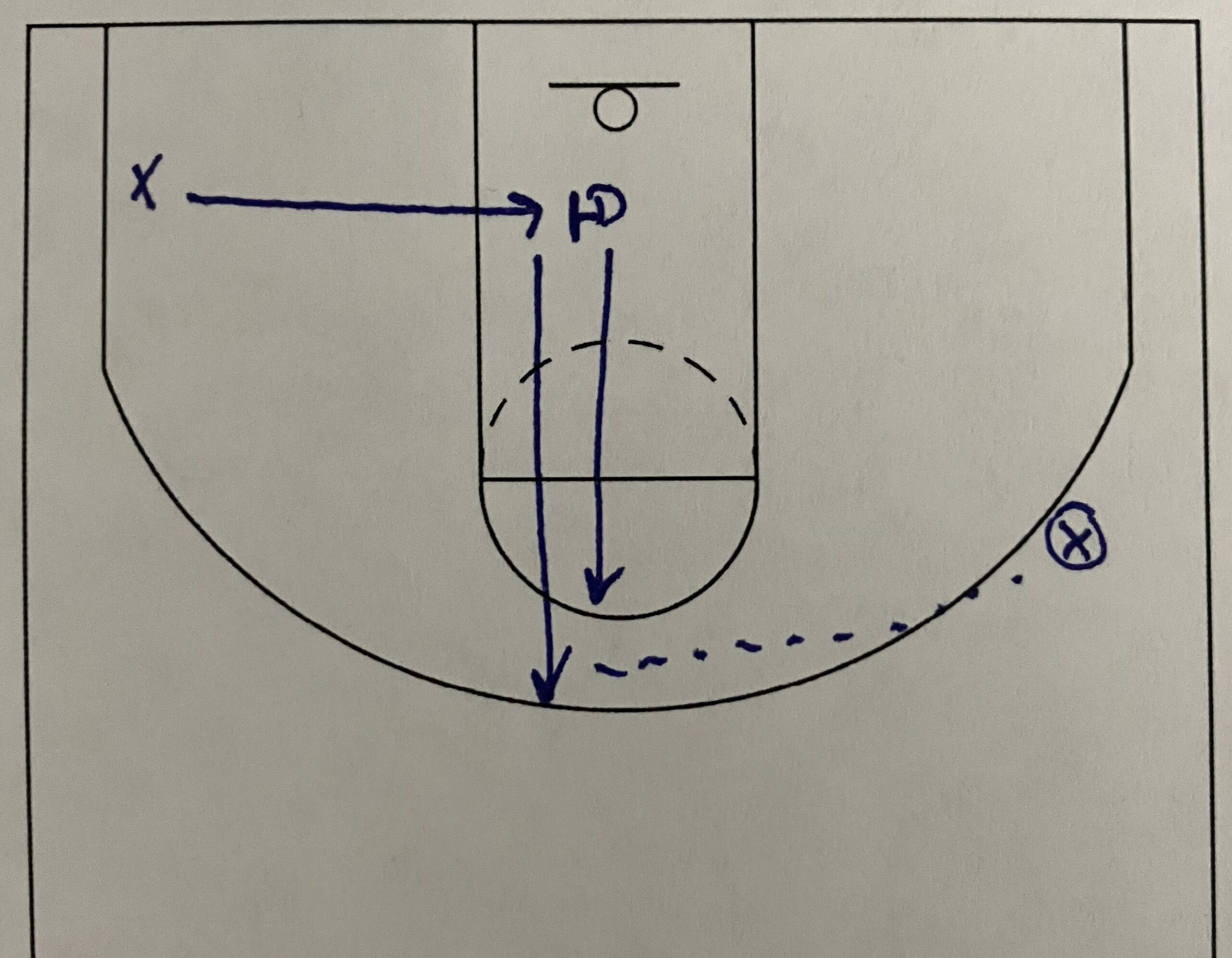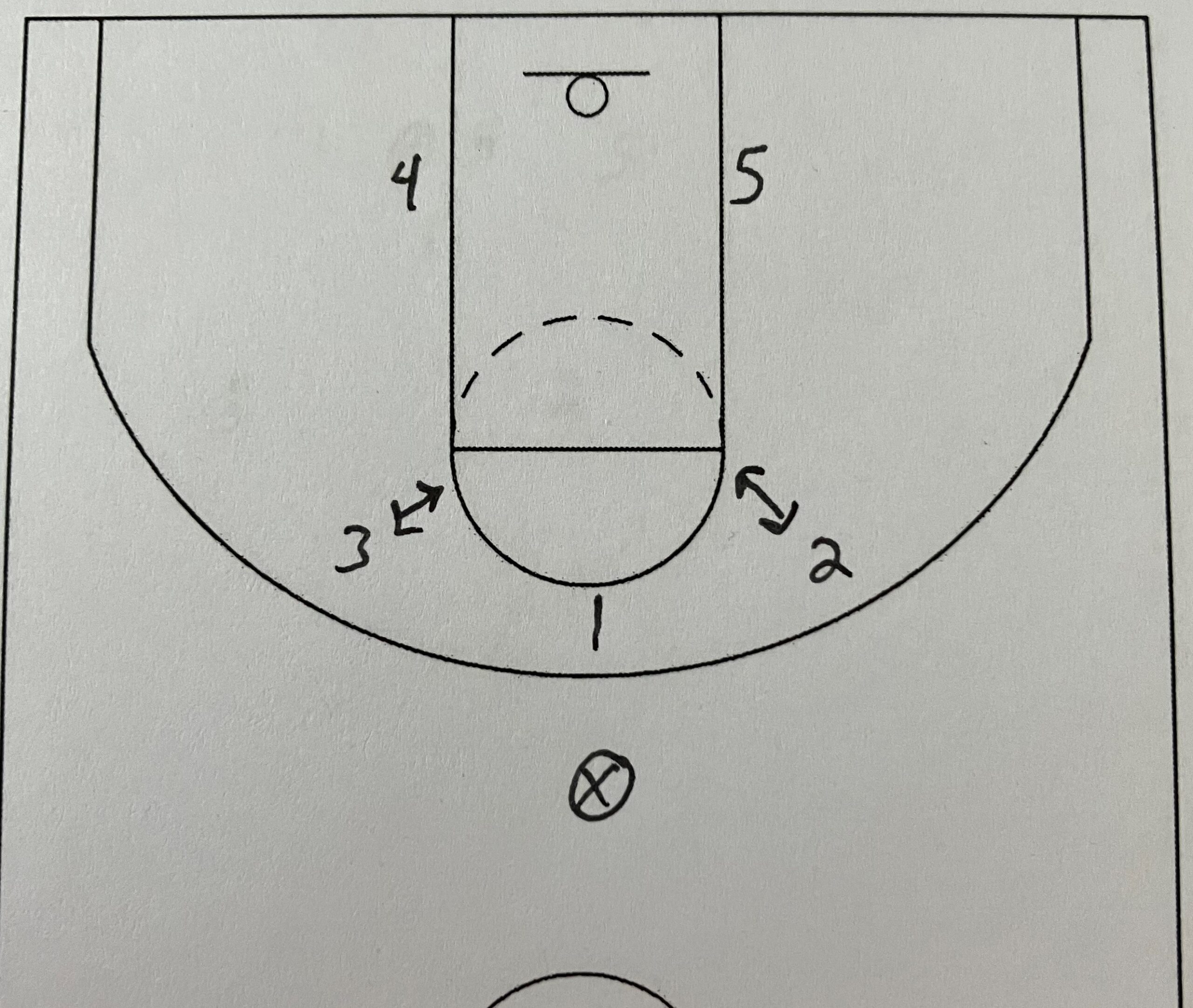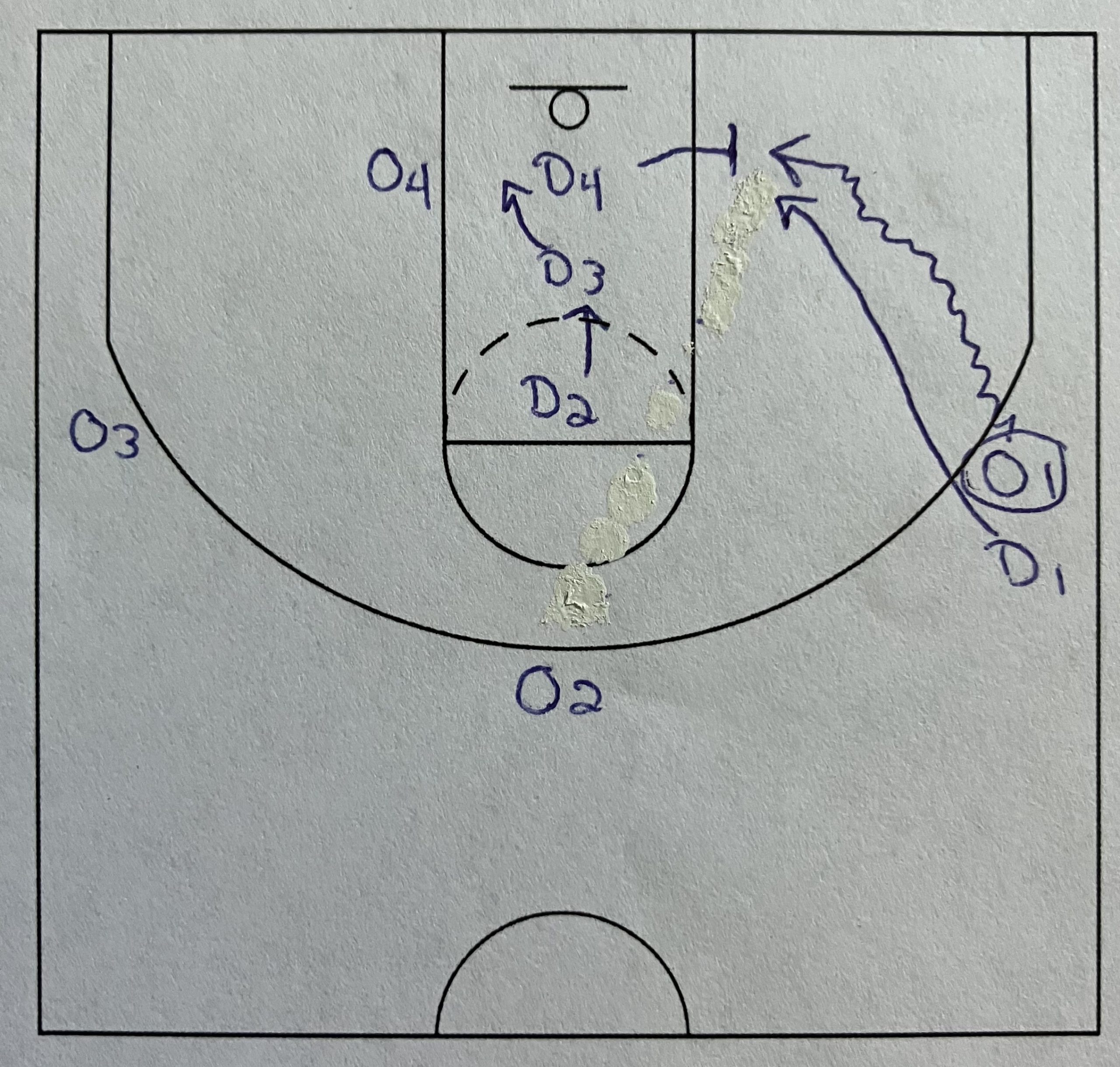What is a 2-3 Zone Defense?
A 2-3 zone defense is a zone defense with a player on each elbow, a player on each block and one player in the middle of the lane. The defense has two players across the foul line and 3 players along the baseline. That is where the 2-3 gets its name.
The 2-3 zone defense is designed to get and keep a bunch of players around the lane. It tries to force the offense to take a bunch of outside shots by keeping every defender closer to the basket. This also has the added effect of trying to gain an edge in rebounding by having so many players around the basket.
The 2-3 zone is usually one of the first zone defenses a player learns growing up. It is also a defense that is used sparingly at the college level and at the pro level. The Syracuse Orangemen and Coach Jim Boeheim used the 2-3 zone for 40 years to great success. The Miami Heat used a 2-3 zone against the Boston Celtics in the 2023 Eastern Conference Finals to help them get to the Finals as an 8-seed. It can be effective at the highest levels of basketball.
What is an “I”-3 Defense?
The “I’-3 defense is a combination defense similar to the Box-1 or Triangle-2. The I-3 defense has 3 defenders guarding man-to-man while the other 2 defenders are guarding in a vertical zone formation. The 3 man defenders are each guarding a particular offensive player while the 2 zone defenders are in a stack formation to guard the other 2 offensive players and be in a better position to help the 3 man defenders.
The 2 zone defenders are stacked with 1 defender at the free throw line and the other at the front of the rim. They are there to help with the man defenders if and when necessary. They are also in a zone formation to guard the 2 offensive players not being guarded man.
In using the I-3 defense, the defense has decided to essentially leave 2 offensive players open thinking they are not going to score many points anyway. This gives those 2 zone defenders a better chance to help or double team the other 3 offensive players. By having more focus on those 3 offensive players, the I-3 defense is trying to reduce the 3 main offensive players scoring to give the defense a better chance to win the game.
Best Team Personal for a 2-3 Zone Defense
There are usually 2 types of teams that run a 2-3 zone. The first is a small team that are trying to pack the lane. By packing the lane, the team should have an easier time rebounding missed shots because the number of players close to the basket. It also helps the defense in being able to surround a good post player with a bunch of defenders. This gives the defense the ability to double team a post player much easier than other defenses.
The other type of team is either a slow team or a tall team. A slow team runs a 2-3 zone because the players are not covering as much of the floor individually, so the lack of speed becomes less of a disadvantage. The players are not having to move much so quick offensive players are not going to be able to exploit their speed advantage.
Likewise, a tall team is going to benefit from the 2-3 zone because their length should cause problems for the offense. The zone is going to reduce the amount of movement for each player, so the size and length of the defense has a greater chance of causing problems for the offense.
The best team personnel for the 2-3 zone is a mixture of speed and length. The 2 guards at the front of the zone should be really quick so they can extend and pressure the ball as much as possible knowing they have help behind them. And the 3 bottom players of the zone should be tall and long. The taller those 3 players are, the harder it is for the offense to score on the inside of the zone.
If the offense cannot score inside the zone, then they have to score from the outside. This is where the quick guards come into play. The faster those 2 guards are the more floor they can cover thus preventing outside shots with their own closeouts. This is the best personnel for a 2-3 zone. Two quick guards and three tall forwards.
Best Team Personal for an “I”-3 Defense
The best team personnel for the I-3 defense is to have 3 really good man-to-man defensive players. These 3 defenders will be matched up to guard the 3 best offensive players.
The other 2 defenders can be anybody. These two are going to stay close to the free throw line and rim. These 2 defenders are there to help the 3 man defenders. And if the offense passes the ball to the 2 non guarded offensive players, then the 2 zone defenders will closeout to them when they are close. Or they will shift so those 2 non guarded offensive players cannot just shoot a layup.
While the 2 zone players can be anybody, the taller these 2 players are the better. The height gives them the ability to contest more shots and rebound better in their zone formation. The height of the 2 zone players would be a plus but it is not required.
When to Use a 2-3 Zone Defense
There are several different reasons why a 2-3 zone should be used defensively. A couple of reasons are because of the defense and a couple of reasons are because of the offensive team the defense is playing against. Sometimes a 2-3 zone is a good choice because of the opponent.
The first reason to use a 2-3 zone is because the defense is unable to guard the opponent’s guards. If the defense cannot defend the guards of the opponent, then the defense is going to be helping constantly. By going to a 2-3 zone, the help side defense is simplified. The help is already behind the defenders making the defense easier and more effective.
The 2nd reason is because the defense is tall and long. Size can greatly influence the outcome of basketball games. A defense that is tall can cover more area than a team that is short. Having tall players and using a 2-3 zone gives the defense the ability to control the middle of the floor and make the offense shoot shots close to the basket over taller players. If the offense cannot shoot over the taller players, then they will be forced to take shots farther away from the basket. The farther away from the basket a team shoots will lead to a lower percentage of made shots which leads to a lower number of points scored.
The 3rd reason is because the opponent are bad outside shooters. If a team cannot shoot from the outside, then a 2-3 zone works because the defense is putting more players closer to the basket forcing the offense to play farther away from the basket.
This is why a 2-3 zone becomes much more effective the younger the players are. A 2-3 zone works great in youth basketball because youth players are usually not good outside shooters. The players are not strong enough yet. The 2-3 zone becomes less effective in high school and even less effective in college because so many players in high school and college are able to shoot from the outside. However, if a team does not have good outside shooters, then a 2-3 zone can still be effective in high school and college.
A coach can scout an opponent. If they see the opponent is not good at shooting outside shots, then they can play a 2-3 zone against them forcing them to do something they are not good at doing.
The 4th and final reason is because the offense has a really good post player. If an opponent has a post player that nobody on defense can guard, then a 2-3 zone can be used to surround that post player with more defenders. By moving into a 2-3 zone, the defense is creating a natural double team scenario anywhere the post player goes on the inside of the zone.
It also puts more defenders closer to the basket for rebounds to try and keep that dominant player from getting a bunch of offensive rebounds. The 2-3 zone should discourage teams from using the post player as much and make the offense use their guards more. The 2-3 zone is trying to force the offense to use other players besides their best post player to score.
When to Use an “I”-3 Defense
The I-3 defense is not a defense used very often. It is a defense that can be used on a very rare basis to cause confusion and uncertainty to the offense. I have only seen it used in a game twice. In both instances the offense struggled for a significant period of time trying to figure out what to do. Ultimately one of the unguarded offensive players was able to make a couple of open shots to give the offense a win.
In both instances the team running the I-3 defense was severely overmatched. A win by the team running the I-3 defense would have been considered a major upset. And in both cases the I-3 gave the severe underdog a chance at winning the game. I can honestly say I was shocked the score was as close as it was when the game ended. And I fully believe the reason the games were so close is because of the I-3 defense.
The I-3 defense can be used to help control and limit an opponent who has 3 main offensive players with 2 roll players. One of the games this defense was used was against a team who had 3 players averaging over 15 points a game and the other 2 were averaging under 5 points a game.
The defense focused all their attention on the 3 main offensive players and gambled the other 2 players averaging less than 5 would still not score even though they were not being guarded. It worked and the game was one to two possession leads through the whole game. It stayed this way until late in the 4th quarter when one of the players scoring less than 5 points a game made a couple of shots in multiple consecutive possessions to stretch the lead out to 10 where it stayed for the last couple of minutes of the game.
This is a defense to be used as a last resort. An underdog team who has very little to no shot of winning the game if they played straight up. The I-3 defense can confuse an offense and keep help in great positions no matter what the offense is doing.
Advantages of a 2-3 Zone Defense Over an “I”-3 Defense
1) Better Positioning for Rebounding
The 2-3 Zone Defense keeps players in and around the basket. By keeping everybody around the basket, defensive rebounding becomes easier. The defense should have at least 3 and sometimes all 5 players within 5-8 feet of the basket on every shot. The number of defenders close to the basket gives the defense a better chance at rebounding the ball.
It can be hard for an offense to get rebounds off of missed shots because the 2-3 Zone covers a lot of the area where rebounds are caught by the zones setup. The 2-3 Zone forces an offense to play more of an outside game so there are less offensive players on the inside. The lack of offensive players on the inside of the zone and the amount of inside space the 2-3 Zone covers makes defensive rebounding much easier.
The I-3 Zone Defense has 3 defenders guarding man and 2 defenders in an “I” zone setup. The 2 zone defenders are playing with one in front of the basket and one around the free throw line. They are moving with the ball and the 2 non guarded offensive players. These two defenders are going to be relied upon by the defense to get a lot of missed shots by the offense.
The 2 zone defenders are at a disadvantage because the offense can move and setup in ways to prevent them from getting in good rebounding position. The 2 non guarded players can move in ways so they can get a good box out against the 2 zone defenders. So, the 2 zone defenders are not always going to be in a good rebounding position.
The 2 zone defenders are going to be following the ball as it moves in the offense. They will be on ball side at all times. Most rebounds are going to come off in the opposite direction from where they were shot. By being ball side, the defenders will not be on the backside where most rebounds will land. The offense can keep one of their players on the backside at all times giving them a better chance at getting a rebound. This can cause problems if the 2 zone defenders cannot recover and get to missed shots.
2) More Defenders Around the Basket
There is a trend among a bunch of high school teams that want to play like the current NBA style where it is a lot of open floor space and a lot of 3’s being shot. The problem with this style is the lack of proficient shooters at the high school level. This style does not work unless the team is making a fairly high percentage of the 3-point shots. I would say 33% or better is needed for a high volume of 3-point shots to be a part of the offense. If 33% is not able to be reached then teams will struggle with scoring.
The 2-3 Zone encourages outside shooting by keeping a lot of players closer to the basket. If a team shoots a lot of 3’s but does not make them, then a 2-3 Zone would be a good defense because it will encourage a team to keep shooting from the outside even when the shots are not going in.
A 2-3 Zone can help stop a dominant post player. More defenders being around the basket gives the post player less space to maneuver. This can help slow down or stop a really good post player. The 2-3 Zone can also help rebounding by keeping players around the basket.
The I-3 Defense has 3 players guarding man and 1 defender up at or above the free throw line. This is leaving only 1 defender at times around the basket. This defender has to be a rim protector, a drive helper, and a primary rebounder for the defense. This is asking a lot out of 1 player.
The I-3 Defense relies on the 3 man defenders being able to stop the 3 best offensive players while also assuming the 2 players not being guarded do not score even with them being left open. The lone defender at the basket has to do a lot of jobs but if they can, then the defense can and will work in the right spots.
3) Less Chance for Open Shots
Any zone is going to give up some open shots at times. However, the I-3 Defense leaves 2 offensive players alone and open at all times except when they have the ball. A quick pass and shot by these players are going to be open most of the time if not all the time. That is the design of the defense and therefore will occur.
Every shot the 2 non-guarded players is one less shot by the 3 main offensive players. But they are still open shots. And if one of these players starts making those open shots, then the defense is not going to work anymore.
The 2-3 Zone may give up an open shot when the offense makes a good play or a defender has a breakdown. But the majority of the time every shot is going to be contested. The defense is going to have to score against a defender rather then a bunch of wide open shots. A contested shot is far less likely of going in, then a wide open shot.
Advantages of an “I”-3 Defense Over a 2-3 Zone Defense
1) More Focus on Best Offensive Players
One of the main reasons to use the I-3 Defense is to maintain good on the ball defense against the 3 main offensive players of the opponent. The 2 zone defenders are in the lane to prevent any drives to the basket and help the 3 on the ball defenders.
The focus of the defense is staying on the 3 best players while the 2 non-guarded offensive players are free to move in the half-court. If a defense is able to get the 4th scoring option of a team to shoot more shots, then the defense should have a good chance to win the game. Most teams have 1 or 2 scoring options. Some have 3 which is where the I-3 defense is needed. Very few teams have more than 3 good scoring options.
So, a defense is forcing non scoring offensive players to be more involved in the offense and take more shots will be advantageous to the defense. The 3 main scorers are being guarded and possibly double teamed when they catch the ball. This helps to force the 4th and 5th scoring options to be more involved.
The 2-3 Defense does not change depending on the offensive players. The most a 2-3 Zone Defense can be is shade the side of the best player and continue to shade to a certain player during each possession.
The best offensive player will still have the freedom to move in the half-court trying to find open space in order to catch the ball and attack offensively. The offense can keep passing and cutting until one of the better scoring options is able to get the ball in a good scoring position.
2) Can Confuse the Offense
The I-3 Defense is not a common defense. I have only seen it ran in a game 1 time in my career. I have installed in 1 time in my career. I did not have to use it in a game but I was prepared to use it if I needed it. There were good coaches who did not know what defense was being used when I saw it in a game. They were confused as to what was happening.
When coaches are confused then the players will be as well. This confusion can lead to indecisiveness and poor decision making. That might be all the defense needs to stay close in a game and potentially pull an upset.
The I-3 defense can be hard to play against because of the lack of familiarity as well as deciding on what kind of offense to ran. Three players are guarding man so does the offense run a man-to-man offense? But two players are playing in a stack zone so will a zone offense work? It can take the offense a long time to figure out how to attack the I-3 defense.
The game I saw it used a team was able to stay close all game and almost pull an upset when the other team was 25+ points better. They had no clue on what to do. Finally, the 4th scoring option made some foul line jumpers to give them the slight lead they needed to win the game.
The 2-3 Zone Defense is one of the first if not the first defense a team is going to install. Along with installing the defense, every team is going to install an offense to play against the 2-3 Defense. A team confused by a 2-3 Zone Defense is a poorly coached team. A 2-3 Zone Offense should be installed after a man-to-man offense is installed.
Teams that struggle against a 2-3 Zone Defense is going to be based on skill or lack of execution. A team should not struggle against a 2-3 Zone Defense because of not knowing what to do.
3) Keeps Outside Pressure While Protecting the Basket
The I-3 Defense is able to keep pressure on the outside with the 3 defenders guarding man to man. But the 2 zone defenders playing in a stack keeps two people around the lane and basket at all times. This gives the I-3 Defense a little bit of positives from both man defense and zone defense.
The problem with any zone defense is the offense will have advantages that the defense cannot change without changing the zone defense. The 2-3 Zone has good inside protection but lacks pressure on the outside. A 1-2-2 Zone keeps good pressure on the outside but gives the offense more space around the lane to attack.
The I-3 Defense keeps good outside pressure by keeping 3 defenders in man but also has good rim protection with the 2 zone players. The problems areas of zone defenses get reduced with the hybrid style of the I-3 Defense.
The 2-3 Zone keeps more defenders in and around the lane so the offense will struggle getting the ball on the inside of the zone. The 2-3 Zone is able to force teams to play more on the outside because of the zone defenders being close to the basket.
However, the 2-3 Zone struggles on keeping good pressure when the ball is around the 3-point line. Any extension by the zone defenders opens the space in the middle of the court the 2-3 Zone is trying to prevent. This is the zone getting an advantage but in turn having to give up a disadvantage.
Which is Better? A 2-3 Zone Defense or an “I”-3 Defense
The I-3 Defense is a very niche defense that can only be ran once or twice a season. And there are times where the I-3 Defense is not a suitable defense for an entire season. This leaves it as an installation against a certain opponent. As that game is coming up then the I-3 Defense can be installed and used.
The 2-3 Zone is one of the most used zone defenses in basketball. It is one of the 1st if not the 1st zone defense a player will learn how to play. While there are little adjustments depending on the team and coach, most 2-3 Zone Defenses are the same.
Once the 2-3 Zone Defense is installed, it can be used against most every opponent. It can be tweaked into more of a 2-3 Matchup Zone if necessary. It can be extended up into a 2-3 Tandem Guard Press. It can be changed just enough to make it fit the needs of the team against each opponent.
The major difference in the two defenses is the amount of time each defense can be used. This is enough to give the 2-3 Zone the advantage over the I-3 Defense and say it is the better defense.



